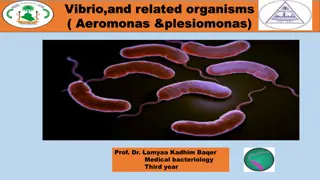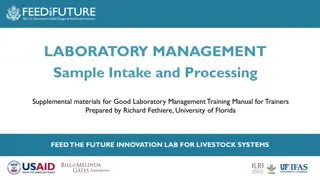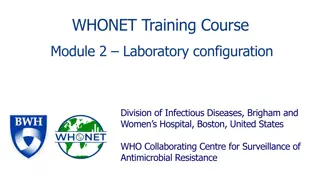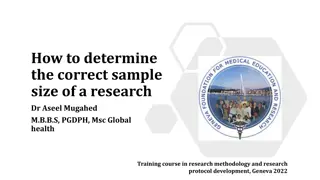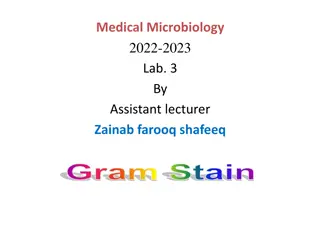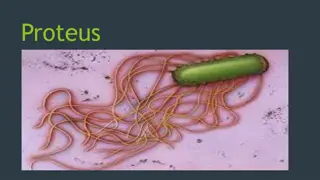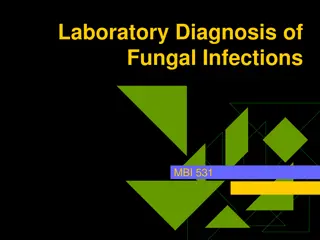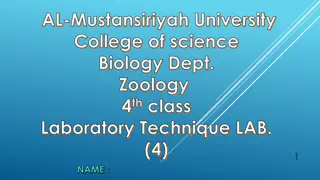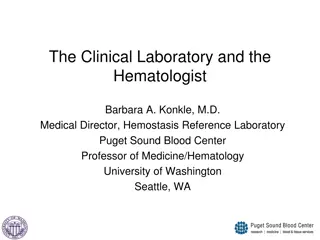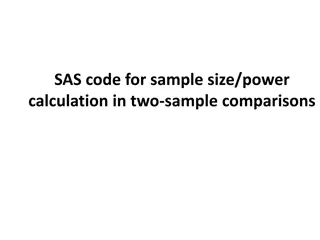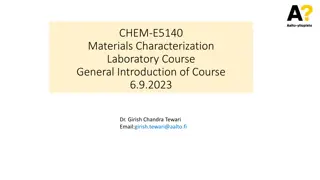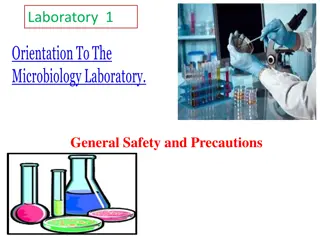Practical Bacteriology Laboratory Diagnosis and Sample Collection
This practical guide focuses on laboratory diagnosis steps in bacteriology, covering specimen collection, microscopic examination, culture tests, biochemical tests, serological tests, and molecular tests. Learn about various sample collection methods for urine, stool, swabs, sputum, pus, CSF, and more. Understand the importance of proper collection and processing techniques to ensure accurate test results.
Download Presentation

Please find below an Image/Link to download the presentation.
The content on the website is provided AS IS for your information and personal use only. It may not be sold, licensed, or shared on other websites without obtaining consent from the author. Download presentation by click this link. If you encounter any issues during the download, it is possible that the publisher has removed the file from their server.
E N D
Presentation Transcript
Practical Bacteriology Practical Bacteriology lab. lab. 2 2 Laboratory diagnosis Smear preparation, Simple and Gram stains By: Asst. Prof. Shiama'a Al-Salihy 1 4/6/2024
Learning objectives: After this lab, you must be able to: 1. Identify laboratory diagnosis steps. 2. Understand staining techniques 3. Illustrate the purpose of each stain 4. Interpret laboratory tests results 2 4/6/2024
Laboratorydiagnosissteps: Specimen: according to type of infection Microscopicexamination : stained orwet Culture and antibiotic susceptibility test: inoculation of M.Os in or/and on culture media, and testing theirsensitivity to antibiotic. Biochemical tests: catalase, coagulase, sugar fermentation tests etc. Serological and immunological test Moleculartests
Sample ,blood, stool ,sputum , pus, CSF, plural fluid ,peritoneal fluid, different types of swabs. collection (specimens): Urine
A. Urine sample: Collection: (M.S.U.) contamination with normal flora (E.coli), saprophyticus. The sample of urine must be no delay more than 1-2hrs. B. Stool sample: In sterile container or by rectal swab. The collected stool should be processed within 2hrs or inoculated in transport media Mid sample stream to urine avoid Staphylococcus urine collection container
C. Swabs: collect the following: 1. Urethral swabs: for urethritis diagnosis in men and vaginal swab 2. Throat swab: chocolate agar 3. Nasopharyngeal swab 4. Ear swab. 5. Eye swab. 6. wound swab. Very important methods for culture on
D. Sputum: Material from lower RTI or ( a mixture of bronchial secretion and inflammatory exudates). Collection steps: Make the collection in a disposables screw-capped container Homogenize the sample. Collect the sample before antibiotic therapy is began. wide mouth plastic Sputum collection container
E. Cerebrospinal fluid (CSF): The examination of CSF is an essential step in the diagnosis of meningitis. Normal CSF is sterile, clear, with no RBCs. Collection: 5-10 ml of CSF should be collected in 2 sterile tube by lumber puncture bacterial and fungal
F. Blood : Samples administration skin antisepsis: Iodine, Povidone Iodine, Alcohol 70% or Chlorhexidine 10 ml from adult, 2 - 5 ml from children, 1-2 ml from infants and neonates of blood should be taken before antibiotic
Microscopic examination: Smear: A thin film of material containing M.Os which is spread over the surface of slide (stained or wet) - Wet preparation are used to demonstrate: Blood cells and microbes in fluid specimens such as urine, feces, CSF Cysts, eggs or parasite in feces. Fungi in skin. Protozoa in blood and tissues. - Stained smear: if bacteria are seen in gram stained smear, their shape, size, arrangement and reaction should be observed.
Staining procedure can also be classified into: 1) Simple staining: It is the use of single basic dye to color the bacterial organism. Such as methylene blue, crystal violet, safranin. 2) Differential staining: uses more than one dyes and it is also used to differentiate the organisms into one of two groups such as gram stain and acid fast stain. Also it can give the shape of bacteria 3) Structural stain: such as capsule stain, endospore and flagella
Gram stain It is a differential stain uses two or more types of dye to differentiate between organism according to their response to these dye Gram Stain a) Gram positive: b)Gram negative: Appears violet after Gram s stain Appears red after Gram s stain
Ziehl-Neelsen stain (Acid fast Bacilli) To tuberculosis High lipid content- makedecolorizationvery difficult Principle: Acid fast (resist): once the bacteria stained with primary dye- difficult to decolorize with acid due to high contain of lipid substances within their cell walls called mycolic acids. Basic carbol fuchsin in combination with phenol (the staining solution) penetrates the cell wall and stain the bacilli bright red. they resist decolorization with strong acid. stain Mycobacterium species especially M.
Steps of AFB stain Mycobacterium tuberculosis under microscope stained with AFB stain
Albert Stain Used for staining and demonstrated of Corynebacterium diphtheriae, They are thin gram positive bacilli which resemble Chinese letters when stained by simple stain. In albert stain another characteristic metachromatic granules (RNA or polymetaphosphate) the granules are bluish-purple by methylene blue and dark purple with albert stain is presence of
Endospore Capsule

 undefined
undefined












